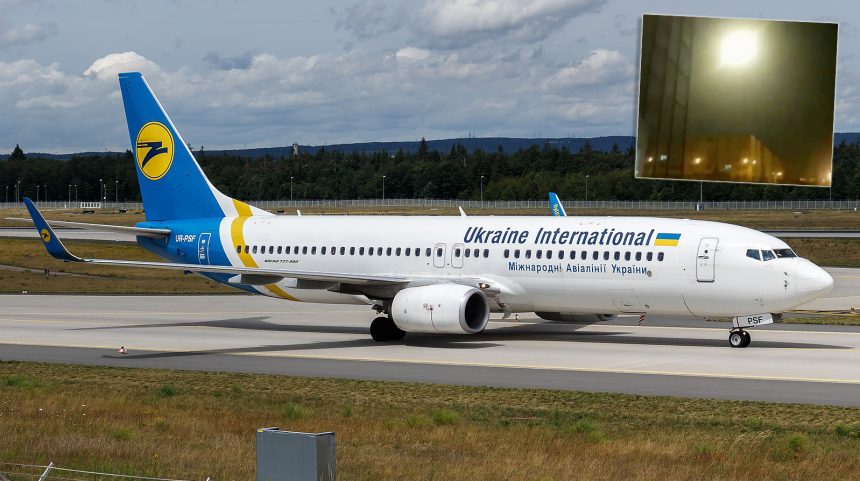Western officials are confident that Iran fired two surface to air missiles that brought down the Ukrainian B737 aircraft as a new video allegedly showing a missile hitting the airliner emerges.
According to various U.S. media outlets, Pentagon has intelligence suggesting Iran may have mistakenly fired two surface-to-air missiles at the Ukraine International Airlines Boeing 737 that crashed shortly after take-off from Iran’s Imam Khomeini airport in Tehran early in the morning on Jan. 8, 2020.
The aircraft, a Boeing 737-800, registration UR-PSR, was flying with 176 people on board, to Kyiv as flight PS752. No one survived the crash.
Shortly after the news of the crash had spread, Iranian authorities stated that the plane had crashed due to technical difficulties and that pilots had attempted to return to the airport.
A video claimed to be of the Ukraine International 737 crashing appeared on Twitter shortly thereafter. It shows an object trailing flames as it descends at a moderate trajectory until it flares brightly on impact. Someone speculated the video was the proof the aircraft was shot down, however the unverified clip alone did not provide any solid basis for the accidental downing theory. Nor did the fact that the FDR (Flight Data Recorder) would not be sent to Boeing.
Photos from the crash site seemed to show some “holes” in various chunks of the plane too. However, once again, these were not the proof the aircraft was shot down:
Hey all, be careful about analysis of holes in various parts of the plane.
For example: these images show the same piece, where at least some of the “holes” actually appear to be small rocks or other debris in higher resolution images. pic.twitter.com/FKhLLMZXf5
— Nick Waters (@N_Waters89) January 8, 2020
As speculations about the cause of the accident went viral, the BBC World News reported that, “Ukraine’s president, Volodymyr Zelensky, warned against ‘speculation or unchecked theories regarding the catastrophe’ until official reports were ready.
National Security and Defense Council Secretary Danylov now says there are SEVEN versions of PS725 crash, four of which are open to public (Russian Tor missile, collision with a drone, engine explosion caused by technical issues, explosion inside the plane caused by terrorism)
— Katya Gorchinskaya (@kgorchinskaya) January 9, 2020
However, the scenario started to change as images of what appeared to be wreckage of 9M331 missile was found near the crash site suggesting that the Boeing 737-8KV was shot-down by a Tor-M1 SAM system (SA-15 Gauntlet).
A number of people have asked why the front of the Tor missile survives intact. As the below diagram shows, the warhead (marked 13) is not in the front of the missile, but about midway. Source https://t.co/msvYkwyEwq (h/t @cthulhu985) pic.twitter.com/Z4rhrHXf8D
— Bellingcat (@bellingcat) January 9, 2020
Eventually U.S. officials made public their confidence, based on intelligence assessment, that Iran accidentally shot down the Ukrainian plane.
.@cbsnews: US officials are confident Ukrainian Flt 752 was shot down by Iran. US intelligence picked up signals of the radar being turned on & satellite detected infrared blips of 2 missile launches, probably SA-15s, followed shortly by another infrared blip of an explosion.
— Kris Van Cleave (@krisvancleave) January 9, 2020
The same version later confirmed by UK media, including the Guardian:
“Western intelligence sources told the Guardian that their assessment suggested two surface-to-air missiles had targeted the plane. Western intelligence agencies are understood to have picked up signals of the missile launches, followed by the traces of an explosion. A British source said: “The assessment is that it looks like it is a tragic accident.” Separately, officials told US media they had identified the signature from an Iranian anti-aircraft missile battery being activated shortly before the aircraft crashed into countryside south-west of the Iranian capital, killing all on 176 on board. The officials also said they had identified the infrared signature from two suspected missile launches followed shortly afterwards by the infrared blip from the burning and fatally disabled aircraft.
Dealing with the way U.S. defense officials may have seen the SAM launch, it is highly probable that the U.S. had the ability to detect both the initial missile attacks on U.S. targets inside al-Asad and Irbil military bases in Iraq and any possible launch of a surface-to-air anti-aircraft missile within Iran, such as the one suspected in the downing of the Ukrainian 737, by means of their IR signature. The U.S. Space-Based Infrared System (SBIRS) is deployed from a series of ten surveillance satellites that send data about probable missile launches back to ground-based reporting stations. The information is transmitted in near-real time.
Meanwhile, a video allegedly showing the SA-15 hitting the airliner has emerged.
New video from Telegram pic.twitter.com/DVBnIgzbwH
— Roman_01 (@Roman_012) January 9, 2020









